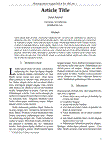| Sumario: | Most nutritional studies with seaweed meals or seaweed extracts have investigated low dietary inclusion rates (lessthan 10%) to establish their possible usefulness as functional (binder effect), nutritional, and nutraceutical (healthprotective effect) supplements in shrimp feeds. The optimum inclusion level varies depending on algae or consumerspecies. In many instances, the inclusion of algae in feed formulations has resulted in improved pellet quality (waterstability, water holding capacity and texture), higher feed intake, improved feed efficiency, better growthperformance and higher animal product quality (higher pigmentation, lower cholesterol content). Additionally,macroalgae contain some active compounds that can improve animal resistance against bacterial and virus diseases.Some seaweed species can be co-cultivated with shrimps, resulting in a sustainable alternative to reduce the need forartificial feed. In this paper the studies on the effects of seaweed inclusion in shrimp feeds or seaweed co-culturewith shrimp will be reviewed.
|
|---|
